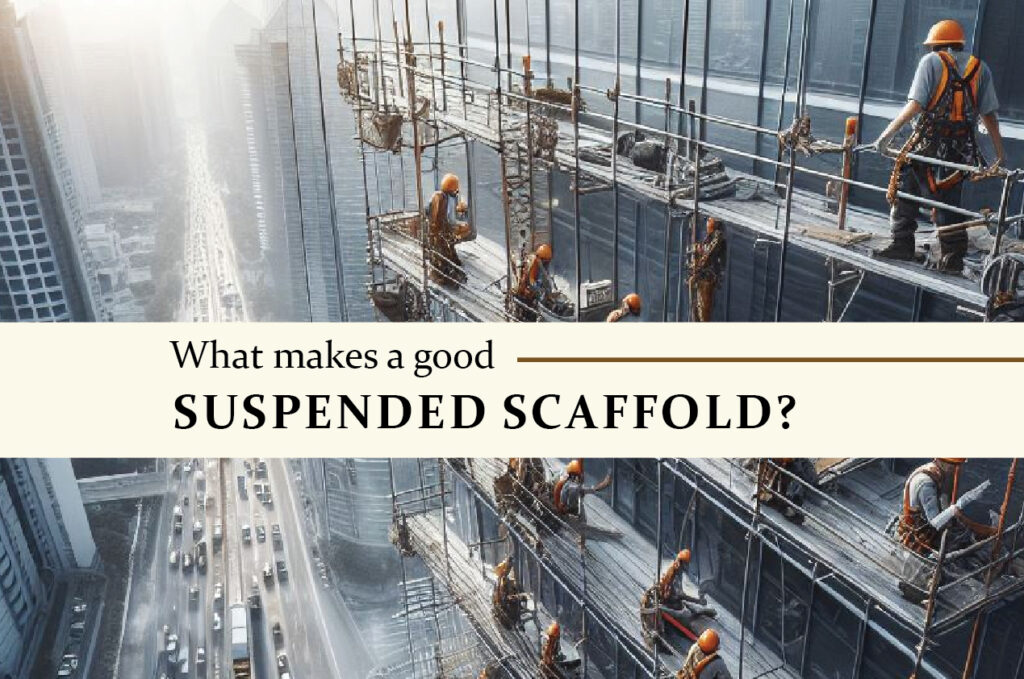
Construction and maintenance projects often require workers to operate at great heights. This is where suspended scaffolds play a pivotal role, offering a secure and versatile platform for work. Whether it’s painting a skyscraper, repairing a bridge, or maintaining a large structure, a well-constructed suspended scaffold is crucial for ensuring safety, efficiency, and functionality.
What is a Suspended Scaffold?
A suspended scaffold is a temporary platform system that hangs from the top of a structure, providing a stable and safe working surface for workers. It’s commonly used in construction, painting, maintenance, and repair tasks that require access to elevated areas.
Key Components of a Suspended Scaffold
- Support Mechanism: The support system is the backbone of a suspended scaffold. It typically consists of ropes, cables, or chains that secure the scaffold to an anchor point on the structure.
- Platform: The platform is the working area where the workers stand or place their tools and materials. It needs to be robust, stable, and spacious enough to accommodate the necessary work.
- Hoist System: The hoist system is responsible for raising, lowering, and suspending the scaffold platform. It includes a motor, pulleys, and other mechanical components.
- Counterweights: In some designs, counterweights are used to balance the load and prevent the scaffold from tipping. They’re crucial for maintaining stability and safety.
- Safety Features: Safety measures such as guardrails, harnesses, and safety nets are integral to protect workers from falls and other potential hazards.
Qualities of a Good Suspended Scaffold
- Compliance with Regulations: A reliable suspended scaffold should meet all relevant safety standards and regulations set by authorities like OSHA (Occupational Safety and Health Administration) in the USA. Compliance ensures that the scaffold is designed, installed, and used safely.
- Quality Scaffolding Parts in the USA: Using high-quality scaffolding parts, which adhere to industry standards and regulations, is paramount. In the USA, sourcing these parts from reputable suppliers ensures durability, reliability, and compliance with safety standards.
- Stability and Load Capacity: A good scaffold must be able to bear the weight of workers, equipment, and materials without compromising its stability. Calculations for load capacity should be precise and adhered to strictly.
- Durability and Maintenance: Components of the scaffold should be durable enough to withstand weather conditions and continuous use. Regular maintenance and inspections are necessary to identify and address any potential issues promptly.
- Easy Assembly and Disassembly: Time is money in construction projects. A well-designed scaffold should be easy to assemble and disassemble without compromising safety. This ensures efficiency and reduces downtime.
- Availability of Scaffolding Accessories Online: Having access to a wide range of scaffolding accessories online streamlines the process of maintaining, repairing, or enhancing the scaffold’s capabilities. This availability allows for easy procurement of additional safety features, spare parts, or upgrades.
What Makes a Good Suspended Scaffold?
A good suspended scaffold, commonly known as a swing stage or suspended platform, is essential for working at heights in construction, maintenance, or repair projects. Several key factors contribute to making a suspended scaffold safe, efficient, and reliable:
- Safety: Safety is paramount. A good scaffold should adhere to rigorous safety standards and regulations. It should be designed, manufactured, installed, and used according to industry standards, ensuring the safety of workers and anyone in the vicinity.
- Sturdiness and Stability: The scaffold should be robust and stable enough to withstand the intended load capacity. It must be able to hold the weight of workers, tools, and materials without swaying or tilting excessively. Proper anchoring and support systems are crucial for stability.
- Quality Materials: High-quality materials, such as strong aluminum or steel, are vital for the scaffold’s structural integrity. The platform and its components should be durable, resistant to corrosion, and capable of withstanding environmental elements.
- Ease of Assembly and Use: A good scaffold should be relatively easy to assemble, disassemble, and maneuver into position. User-friendly design elements, like easily accessible controls for raising and lowering the platform, contribute to efficiency and safety.
- Adjustability and Flexibility: Height adjustability is critical to accommodate different work requirements and heights. The ability to customize the platform size and shape to fit specific project needs enhances its usefulness.
- Fall Protection Systems: Built-in safety features like guardrails, safety nets, harness anchor points, and emergency descent mechanisms are essential for preventing falls and ensuring the safety of workers in case of an emergency.
- Regular Maintenance and Inspections: Regular inspections and maintenance protocols should be in place to ensure the scaffold remains in optimal condition. Periodic checks for wear and tear, as well as adherence to safety standards, are crucial.
- Training and Certification: Proper training for workers who will use the scaffold is imperative. They should be well-versed in its operation, safety protocols, and emergency procedures. Certifications or licenses might be necessary depending on regional regulations.
- Risk Assessment: Before use, a comprehensive risk assessment should be conducted to identify potential hazards and implement appropriate safety measures.
- Compliance with Regulations: The scaffold must comply with local, national, and international regulations and standards related to construction, workplace safety, and suspended scaffolding specifically.
By considering these factors, a well-designed and properly maintained suspended scaffold can provide a safe and efficient platform for workers to perform tasks at heights, contributing to the success and safety of various construction and maintenance projects.
Conclusion
Suspended scaffolds are indispensable tools in the construction and maintenance industry. A reliable scaffold should prioritize safety, quality parts, compliance with regulations, and durability. Understanding the key components and qualities of a good suspended scaffold is crucial in ensuring a secure and efficient working environment at heights.
For those seeking high-quality scaffolding parts in the USA or looking to buy scaffolding accessories online, reputable suppliers such as Scaffold Supply offer a range of products that meet industry standards, enhancing the safety and functionality of these critical work platforms.











Comments are closed